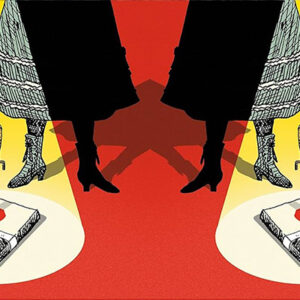In 2023, two new novels, and one older title, were published in a niche of the detective/thriller genre concerning, to coin a term of art, “sinister films:” films—often lost, frequently silent, and usually scary—that have proven deleterious to their cast and crew during and after production and/or have a deleterious effect upon audiences unlucky enough to view them post-production. The three titles are: The Devil’s Playground by Craig Russell, Silver Nitrate by Silvia Moreno- Garcia, and Ancient Images by Ramsey Campbell (first published in 1989). I’ve always been fascinated, indeed professionally so, by this genre so the arrival, and timing, of these three books is particularly interesting. And, I think, no coincidence.
Begin with definitions. Novels concerning sinister films contain one of the following subjects (or some combination of these): the “cursed” film, the film that fucks with the audience’s head, and the “lost” film.
1. The Cursed Film. I’ve always had a sneaking suspicion that the roots of this novelistic genre can be traced to the so-called “curse” associated with the 1922 discovery of the tomb of King Tutankhamun. A year later, George Herbert, 5th Earl of Carnarvon, the individual who bankrolled the tomb’s discovery, did in fact die from a blood-related malady. Still, the idea that disturbing the tomb released some kind of malevolent force that touched the lives of anybody else, including every individual who entered the tomb (I visited in 1999 and experienced no ill- effects) seems to have been mostly an invention of authors and tabloid journalists, albeit one that has persisted for a century.
Instead, the more immediate inspiration for this genre is probably the 1973 horror movie, The Exorcist. The movie, of course, is about an adolescent girl living in Washington, D.C. who becomes possessed by a demon. Unsurprisingly, the movie’s plot gave rise to the legend that making the movie summoned an actual demon who proceeded to bedevil cast and crew. In fact, the shoot does seem to have been somewhat problem-plagued, but not necessarily more than any big budget movie—and much of the cast and crew are still alive in 2023 (its director, William Friedkin, passed away in 2023 and that was fifty years after supposedly encountering the movie’s curse).
My original script for the movie Shadow of the Vampire (2000) also falls into the cursed movie category. It’s a fictionalized account of the filming of the first-ever vampire movie, F.W. Murnau’s 1922 Nosferatu (Two quick digressions: first, Nosferatu wasn’t actually the first vampire movie; rather it’s the first one to survive. There’s evidence of a lost (!) 1920 Hungarian vampire movie, itself perhaps a version of Dracula. Also Nosferatu nearly became a lost film itself: the film is an unauthorized version of Dracula and, having lost in the courts, the producers were ordered to destroy all prints of the film. Fortunately for film history, it didn’t happen).
Two things inspired me to write the script: the first is the fact that the film, shot on location throughout Germany and Eastern Europe, is surprisingly—disturbingly—realistic for a horror movie—if you don’t believe me, just compare it to 1920’s The Cabinet of Doctor Caligari (which is frequently paired with Nosferatu on Halloween double features) or the Universal horror movies of the 1930s. The second is the fact that the film’s most fantastical feature, the rat-faced vampire, Count Orlok, was played by an actor called Max Schreck. Since “Schreck” is German for fright, it must be a stage name, right? And since Max Schreck never appeared in any other movies before or after Nosferatu, it stands to reason a verisimilitude-obsessed director (as a matter of fact, Murnau’s last film was a documentary of sorts: Tabu: A Story of the South Seas) might have cast a real vampire in the role (film historians have since kindly pointed out I was in error about Schreck). The tension between the film’s realistic mise en scéne and its utterly unrealistic vampire became my springboard into the story: strange things plague Nosferatu’s locations until, at last, a couple members of the crew discover Murnau has made a Faustian bargain with a supernatural villain. He cast an actual vampire as Count Orlok and bought the creature’s cooperation by allowing him to make a meal of the leading lady in the movie’s penultimate shot (I really do owe the great director an apology. Janet Gaynor, for one, who acted in his 1927 film Sunrise, remembered him as a fine gentleman).
2. Films that Fuck with the Audience’s Head. Remember the scene in 1999’s Fight Club where Brad Pitt, working as a projectionist, furthered his anarchic cause by editing, at various intervals, single pornographic frames into children’s movies? The idea that this methodology could evoke a response from the audience which registered below the audience’s capacity for conscious perception (little kids crying in horror, parents gasping in shock) is based on a concept called “subliminal stimuli” or “subliminal messaging.” It’s also, as far as I can tell, something of an urban myth. But the device crops up, as established fact, pretty frequently in these novels in order to explain a sinister film’s inexplicable capacity to elicit extreme responses from audiences (as if Freaks or The Exorcist needed any help).
It should also be noted that not all the movies that fuck with your head rely on subliminal trickery. In David Foster Wallace’s novel Infinite Jest (1996), for instance, the movie in question, “the entertainment,” contains no subliminal edits: it’s merely shot from the POV of a child lying in a crib looking up at his/her beautiful, mother. The image is so compelling that it renders adults utterly helpless and, in such a state, they die (not unlike the old Monty Python sketch about the secret weapon that won World War II: a joke so funny the German army dies of laughter the moment they hear it).
3. Lost Movies. As I suggested above, the “lost” film genre is interestingly timely. In this variety of the genre, a movie—often a silent movie (of which so many are truly lost) and often a silent horror movie—becomes the subject of a hunt on behalf of an interested, often obsessed, movie buff. Which raises three intriguing question: why is the lost movie often a horror movie? Why is it often silent? And why is it significant that it’s lost?
I think the underlying answer to the first question is because the most famous lost movie is, in fact, a horror movie. London After Midnight was a 1927 MGM thriller directed by Tod Browning and starring Lon Chaney who appears in surviving publicity photos as a sawtooth vampire sporting prominent bags under his eyes and a beaver pelt top hat (Stephen Rea paid homage to Chaney’s vampire in the 1994 film, Interview with the Vampire). To be honest, the plot of London After Midnight actually doesn’t sound very promising: Chaney turns out to be a Scotland Yard investigator who, like a character in a Scooby Doo cartoon, is merely masquerading as a vampire to smoke out a criminal. But to movie fans, the really interesting thing about the film, the only copy of which was lost in a fire in the 1960s, is that it was expected to be Chaney’s first outing as a vampire. Chaney was on the shortlist to play a more celebrated bloodsucker: Count Dracula in Browning’s famous (and, in my opinion, stilted and barely watchable) version, the one that propelled Bela Lugosi to stardom. Unfortunately, Chaney died of cancer about a year before filming began.
Another reason the lost movies are often horror movies is because the unstated subject of the best horror movies is nearly always: this isn’t a movie. Which is to say, this wasn’t something scripted and performed by actors on a stage in front of motion picture cameras. It’s the real thing, an authentic document—literally a documentary—that actually captured for posterity some really nasty atrocity. And which, rather frighteningly, merely wants rediscovering. It’s also probably why so-called “found footage” films, like 1996’s The Blair Witch Project, are so unsettling.
What’s more, I think the lack of sound adds another dimension of terror to the lost silent horror movies. Historical footage—of wars, holocaust, disasters, etc.—are among the most frightening documents ever projected onto a screen and the absence of sound somehow makes them more believable, as though the cinematographer bearing witness accidentally stumbled upon the scene and had only a few silent seconds to capture its awfulness (I vaguely remember reading a review of, I think, Tod Browning’s 1932 film Freaks which contained the line “This movie would be harder to shake off if it were silent.” Just so).
So what’s the significance of the film being lost? And why is this subject currently in the zeitgeist? My two cents: is it just me, or does it seem like the movies as a whole are on the verge of becoming lost? There are myriad new technologies that make it vastly easier to make movies, there are more venues to watch them than ever before, and it’s possible to pretty much watch anything your heart desires on demand—a far cry from when I was growing up in the 1960s and movie equipment was prohibitively expensive, there were exactly five television channels, and revival houses were few and far between. But after streaming, COVID, and the writers’ and actors’ strikes, something seems to have shifted in the tectonic plates of producing and watching movies. Most notably, the rituals associated with films—the anticipation of a movie’s release, the pleasant conviction that you will spend at least one weekend evening at the movies—feel like rites on the edge of extinction. How many movies have you seen in a movie theater since the waning of COVID? How many theaters are still operating in your neighborhood? The sad fact is, to paraphrase Yeats, “the ceremony of cinema is drowned.”
We’re reading about lost movies right now because the movies themselves feel like they will soon be lost.
So here are the three novels on the subject issued this year and two earlier titles which fall into the same category. No doubt there are others out there and I apologize for not locating all of them.
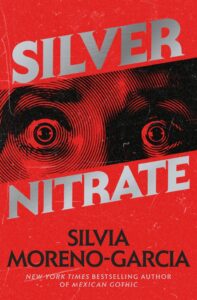
Silver Nitrate (2023), Silvia Moreno-Garcia
In Mexico City in 1993, a sound editor called Montserrat Curiel and her best friend, an actor called Tristán Abascal, befriend an elderly motion picture director called Abel Ureta (the directors in these novels are inevitably foreign-born, often German). A legendary figure to horror movie aficionados, Ureta is best remembered for his 1961 horror movie called Beyond the Yellow Door, since lost, about a young woman who happens upon a Satanic cult. In addition, the film enjoys a reputation as a cursed movie because everyone involved with it either came to a bad end or suffered afterward from rotten luck.
This was, in fact, the intention of the movie’s co-screenwriter, a Nazi occultist called Wilhelm Friedrich Ewers, who believed the early, highly flammable silver nitrate film stock, when combined with dubbed sound and projected in front of an audience, would have supernatural powers: specifically, the power to bring the aging occultist back from the dead. To achieve this, he embedded occult incantations in his script which, when eventually dubbed over a single surviving reel of the film in Ureta’s possession, threatens to revive the Nazi and destroy the lives and sanity of the actor, the editor, and the director.
I ask you: who doesn’t love a good Nazi occult story? I also enjoyed the setting of the novel and its details about life in and around Mexico’s film and television industries in the ‘90s which, it’s implied, is about to cease to exist—a tiny verification of my hypothesis about the meaning of the lost film genre. But I confess I found the ins-and-outs of the occult conspiracy confusing and the extensive descriptions of the backstories of the two main characters (the editor and the actor) uninteresting and ultimately untethered to the sinister film plot.
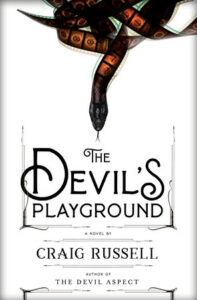
The Devil’s Playground (2023), Craig Russell
In 1967, a mysterious benefactor hires a film historian, Paul Conway, with a reputation for finding lost films, to retrieve the greatest lost horror film ever made: the 1927 silent film, “The Devil’s Playground.”
In another novel, the plot might track Mr. Conway’s hunt for the film, of which one copy is rumored to survive. Alas, one of the disappointments of the book is there is no hunt; the benefactor knows exactly where the last extant print is located and merely hires the film historian to acquire it. There are several interesting reveals and twists at the end, but without the procedural aspect it’s something of a let-down.
The bulk of the novel is set in 1927 Hollywood, during the filming of The Devil’s Playground and is mainly concerned with the efforts of a studio fixer, Mary Rourke, to keep the troubled production from going off the rails. And since the novel falls into the category of “cursed productions,” she has her work cut out for her, beginning with the murder of the movie’s glamorous leading lady, the accidental incineration of a slew of extras during an out-of-control conflagration scene, and the apparent suicide of the head of the studio producing the movie.
There are hints of Satanic cults associated with the film’s principals (including the film’s director who, of course, is German) and there are several flashbacks to the life of a bayou-dwelling witch in turn-of-the-century Louisiana whose tragic story may hold the key to the events surrounding the film.
The missing movie is set in Medieval France. A prosperous town, renowned for its artisans, switches its allegiance from God to Satan in a Faustian bargain that promises to spare it from the ravages of the plague. Unfortunately, sparing the town from disease doesn’t spare it from sin and the place descends into decadence (one of the funniest touches is when the movie’s screenwriter volunteers that the film is an allegory for Hollywood itself, yet another indication that “lost” movies are a harbinger of a vanishing industry).
The movie also falls into the category of “movies that fuck with the audience’s head:” there is, to make its intentions plain, an intertitle card at the beginning of the film warning that if this chapter of the devil’s story is ever told, the devil himself will once again “walk upon the earth” (it’s no coincidence that both Murnau and Friedkin were accused of this same bit of black magic). Unfortunately, this promising subplot is mostly discarded.
The book is strong on Hollywood minutiae and history and is especially evocative when it resurrects the role of Black people and women in the film industry during its infancy. The popularity of occult practice during the period, which roughly parallels the emergence of occultist Aleister Crowley and his Golden Dawn movement in Europe, is also a nice touch, although ultimately a little boring.
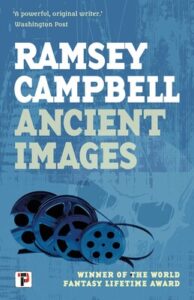
Ancient Images (1989, reprinted in 2023), Ramsey Campbell
A television researcher (it’s never made explicit, but presumably this is in the 1980s; anyway, nobody has a cellphone and there are a lot of convenient pay phones) named Graham Nolan manages to track down a famous “lost” film: a 1930s horror movie, shot in England and officially suppressed before its release, starring Boris Karloff and Bela Lugosi called Tower of Fear. Actually, there was no such movie, but Karloff and Lugosi did star in ten films together, including 1934’s The Black Cat, one of the most exceedingly weird horror (if you can even call it that) movies ever produced by Hollywood.
Before Graham can screen it for a TV editor friend, Sandy Allen, and Graham’s gay housemate (there’s a fair amount of homophobia in the novel, although I couldn’t tell you why), the print is stolen and he is either pushed or jumps from a rooftop to his death (I had to reread this sequence a couple times and still don’t know exactly what happened). In honor of her friend, Sandy dedicates herself to locating another print of the movie.
Most of her odyssey involves retracing her dead friend’s investigation into the whereabouts of the since-stolen print. This entails interviewing a lot of elderly individuals who worked on the film sixty years earlier. To a man, these individuals had a horrific time during the shoot and thus Tower of Fear qualifies as a “cursed production;” in fact, the director (British born, evidently) died in a car accident the week the movie was finished. As a result, not one man among them (and they’re all men) wants to talk to Sandy about their experience so they don’t provide much insight and the reader becomes as frustrated with their unwillingness to cooperate as Sandy herself. They’re also eccentric as hell so the book tips into the “odd sods in a pub” genre typical of a lot of baggy movies and television set in the English countryside.
Sandy also really doesn’t track the movie down. A deus ex machina calls her more or less out of the blue and informs her where she can find a print. And what a vague pointless bore the film turns out to be: Karloff plays a nobleman who lives (or visits or something) a tower to survey his property and in some manner causes the death of Lugosi’s brother-in-law, who Lugosi later avenges by pitching Karloff off it.
Just as weirdly, before and after she screens the film, the novel veers into The Wicker Man territory (the kind-of-great but nutty 1973 movie, not the ghastly 2006 Nic Cage remake): it turns out the individual who had the movie suppressed back in the 30s is a titled nob who presides over a pagan village that actually does have a big tower. Flash forward to the 80s, and there’s even a caravan of “wicker man”-like hippies. Back in the 30s, the titled nob felt the movie slandered his family and he not only had the film suppressed, but he may have called upon the army of animated scarecrows, that haunt his property, to kill the film’s director. It’s hard not to detect a subtext here where the “lost” movie becomes a metaphor for the vanishing power of the English gentry. Whatever. The novel also opens with a graphic scene of a woman, possibly a witch, being burned at the stake whose significance to the subsequent story, if you held a gun to my head, I couldn’t tell you.
As you can tell, I really didn’t care for this novel and one of the reasons is because of all the driving. Sandy is behind the wheel of a car for at least thirty percent of this novel, which means one spends a lot of time reading about her shifting gears and pressing pedals as well as glimpsing potentially scary things in the rearview mirror.

Night Film (2013), Marisha Pessl
After a young woman, a former piano prodigy, commits suicide, a disgraced journalist, Scott McGrath, along with a team of like-minded misfits, investigates the circumstances of her death hoping in part to shed light on her reclusive father: a mysterious Spanish-born (a foreigner, of course) director famous for his Kubrick-like obsessiveness and fuck-with-your-head movies.
This isn’t a “lost” movie novel. It’s more of a “difficult-to-find” movie novel: prints exist of the director’s films and a cult has sprung up around them; it’s just a matter of locating the films and bargaining one’s way into their infrequent underground screenings. All fifteen of the director’s films are named and fragments of their plots are parceled out in the novel whenever relevant (there’s also a very long and very tiresome sequence when the journalist wanders through the still-standing sets of several of the movies where each prop evokes details of the movies’ plots). Thankfully, we’re mostly spared a comprehensive description of the films’ plots (always the most boring part of these books) but they seem to be about cruelty and the abuse of power.
It’s also not exactly a “cursed production” novel, although many people who worked on the films had life changing experiences. As our intrepid investigators follow the trail of clues leading to the explanation of the young woman’s suicide, they also discover hints of torture and pedophilia, rumors of Satanic rituals, a possible soul possessed by the devil, evidence of human trafficking, a possibly haunted Indian burial site—and the likelihood that none of it is remotely true.
I didn’t think this novel had much to say about the movies, although it labors mightily to locate the centrality of horror in human experience; I suspect the author would agree with me that the best horror movies approach the condition of documentaries (apologies to Walter Pater). Also, the procedural beats, twists, and reveals weren’t all that riveting. I’ll admit the little team of misfit investigators was likeable and they had appealing backstories, but the most original thing about the novel might be the fact that it’s often told through internet screenshots—the 21st century version of an epistolary novel (much like Dracula, in fact, which is told through letters and diaries).
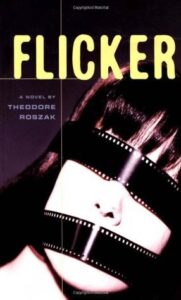
Flicker (1991), Theodore Roszak
In 1950s Los Angeles, a UCLA film studies major called Jonathan Gates takes a part-time job at a down-at-heels revival house where he rediscovers the work of a director called Max Castle. The silent movies Castle shot in his native Germany (of course), said to be masterpieces, are mostly lost but the B-movies he directed in Hollywood after the start of World War II are mainly extant (Castle’s biography contains a lot of Fritz Lang’s DNA). Gates then proceeds to build a celebrated career as a film scholar based upon his rediscovery of the forgotten director (it doesn’t hurt that he has an affair with a Pauline Kael-like movie critic before her renown at “The New Yorker”). Eventually Gates’ scholarship turns Castle’s filmography into a full-blown cult, although I must admit the novel’s descriptions of the movies he shot in America sound pretty cheesy, if not downright Ed Wood-like.
Much of the novel involves Gates tracking down pristine prints of Castle’s work which is important because the uncanny power of his films turns out to be a result of the fact that he was a master at subliminal stimuli. What’s more, Castle used this form of subconscious manipulation in order to promote the tenets of an apocalyptic religion whose connections with the medieval Knights Templar give the book a paranoid, Umberto Eco-like conspiracy patina (Eco famously defined one quality of a lunatic as “sooner or later he brings up the Templars”). When
Gates discovers the religion actually exists and, in part, is actively training its adepts in filmmaking as part of their end-of-times beliefs, the novel takes a more than slightly zany twist which ends with Gates and Castle (thought to have died during World War II) re-editing old movies while stranded on a desert island (!).
This is the mother-of-all “lost” movie novels (it’s also the longest) and it spends a great deal of time discussing, in an insightful and in-depth manner, film theory and history. There are even a couple of fun cameos by film luminaries such as John Huston and Orson Welles. It’s also a classic fuck-with-your-head movie novel and, regrettably, a great deal of time is spent describing Castle’s subliminal effects, which is just as boring as the descriptions of the “lost” movies featured in the other novels discussed here.
The author’s point seems to be that movies are unusually conducive to bringing about the end of the world, especially among the media-addled baby boomers corrupted by TV and pop culture after the war—an unsurprising assertion by someone who puts too much credence in the theory of subliminal simulation. But, to his credit, he recognizes the intrinsic value of the art to the extent that he believes the movies’ saving grace is the artistry of their auteurs. I don’t much mind the later proposition and the former one seems very much of the novel’s post-war setting. But time and the internet have given some credence to it.
















